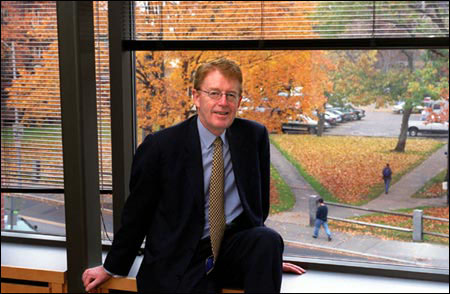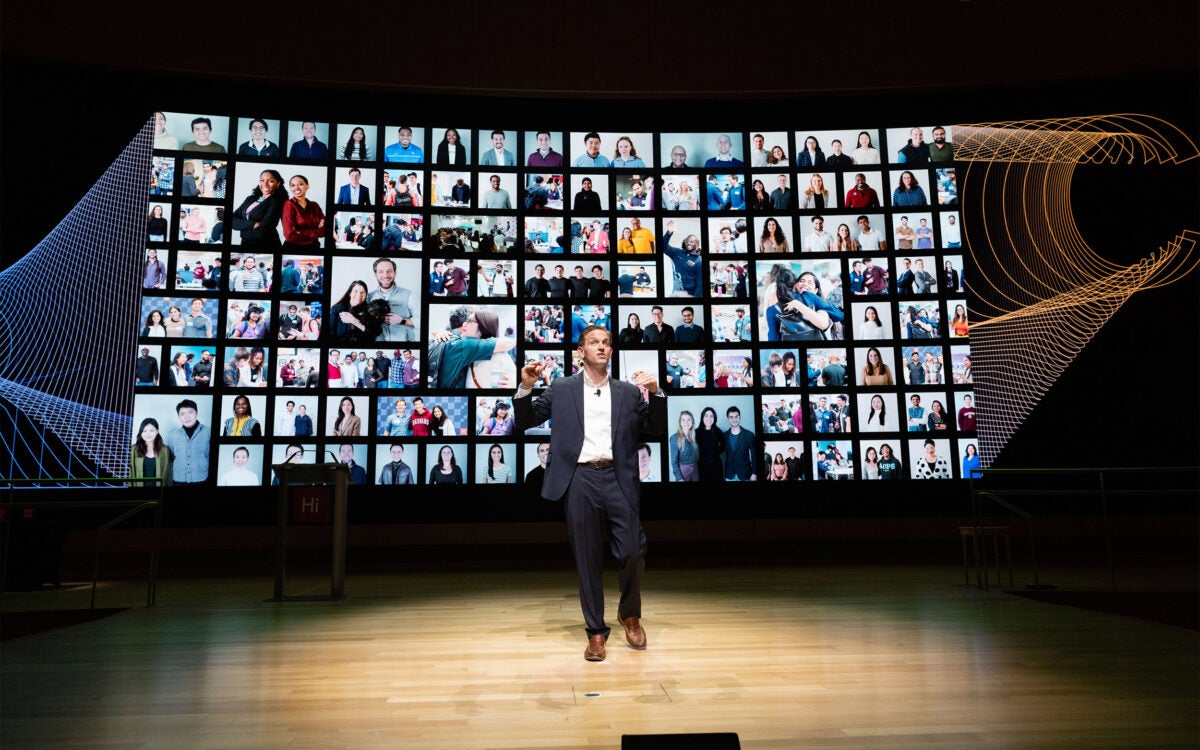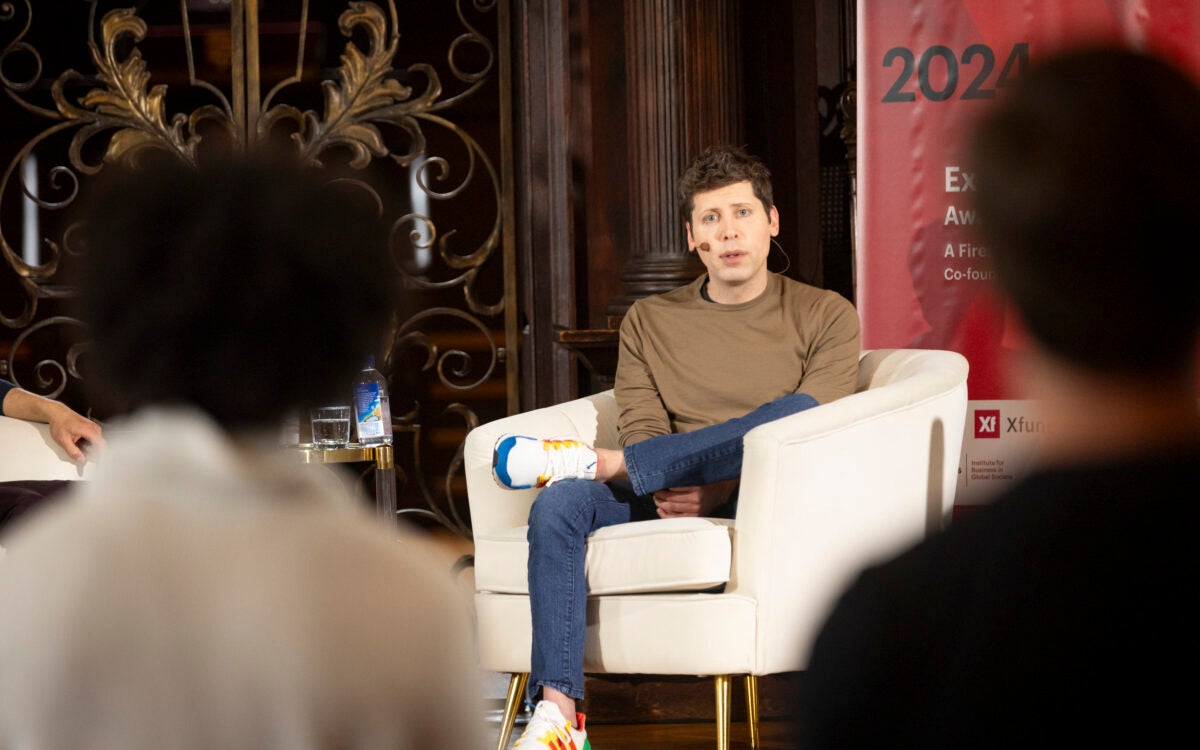McElroy says it’s time to stop seeing global warming as political issue:
‘This is not controversial,’ he says

After a summer of scorching heat waves up and down the Eastern seaboard, apocalyptic flooding in Prague and Dresden, droughts parching the western United States, and population-displacing monsoons throughout the Himalayas, if there is still anyone out there who does not believe in global warming, Michael B. McElroy, Gilbert Butler Professor of Environmental Studies and director of Harvard’s Center for the Environment, has a message for them: “This is not controversial,” he says. “It’s not just a gentle warming. And it’s caused by us.”
McElroy is among the scientists who since the 1970s have been using paleoclimatic data to chart changes in the earth’s atmosphere. To obtain these data, researchers drill several kilometers down into polar ice sheets and extract gases from the tiny air bubbles trapped inside. Through these, says McElroy, “you can not only infer a surrogate for temperature, but you can also measure the composition of the atmosphere at that point in the earth’s history. There is a close association between climate and the level of gases like CO2 and methane.”
In general terms, he says, climate is determined by the amount of sunlight that’s absorbed by the planet, balanced by the way the radiation is emitted back to space – which is in turn influenced by the amount of greenhouse gases in the atmosphere. Among the substances that block the radiation, holding it close to the earth’s surface and contributing to an increase in surface temperatures and all sorts of secondary and tertiary effects, are methane, nitrous oxide, water vapor, and, in particular, carbon dioxide.
“We have raised the level of carbon dioxide in the atmosphere to a point that is higher than at any time over the past 450,000 years,” McElroy says. “Arguably, it’s higher than it’s been for several million years. Concentrations of CO2 will climb to twice what they currently are by the end of the century. That’s a complete change in the atmosphere.”
According to McElroy, for 450,000 years, which is the furthest back ice-core data are able to go, the earth’s levels of carbon dioxide have oscillated between about 200 and 280 parts per million – until you get to the modern era, beginning around the Industrial Revolution, when human activity begins to play a major role. “Then you see levels of CO2 take off,” he says, pointing to a graph in his new book, “The Atmospheric Environment: Effects of Human Activity.” “It’s now about 360 parts per million. See how it shoots up in just 200 years?” The line, indeed, goes from roughly horizontal between 1000 and 1800 a.d., to nearly vertical these past two centuries – indicating that the contemporary change may be unprecedented in its rapidity and raising concerns that there may not be enough time for earth and its populations to adjust.
“This is an indication of a possible shift where you go from having rainfall over three regions of the tropics to over one region,” he says, pointing to model simulations of future climates depicted on the book’s cover. “That kind of climate change is a big deal. It can cause a spread in tropical diseases like malaria, cholera, dengue – diseases that are actually beginning to spread right now. You could expect extreme phenomena like the recent heat wave in India that killed more than 1,200 people. You may anticipate droughts like the one in Afghanistan, which persisted for four years, up until a few months ago.
“In the ancient world what would have happened,” he continues, clearly impassioned, “is that if one region was under stress, people would have taken up their tents and gone somewhere else. But now you have soldiers at borders and people who are in dire straits, who are starved and sick. You have Somalias, you have Rwandas, you have Afghanistans. And anybody who thinks that if CNN doesn’t cover it then it doesn’t affect you….” He trails off. There is no need to complete the sentence.
Unfortunately, understanding the problem does nothing to alleviate it without changes in public policy. Scientists have been sounding the alarm for decades; politicians seem to stir every few years, but most just roll over and hit the “snooze” button.
According to McElroy, the current administration’s nonresponse to its own acknowledgment of the problem – President Bush has declared that the United States should adapt to the inevitable changes rather than work to turn the tide – is hardly unique. “We have done nothing to address this problem in the United States,” he says. “And when I say we have done nothing, it’s not a matter of criticizing the Bush administration, because the Clinton and Gore administration, while more proactive, was also ineffective.” Meantime, the United States remains the number one producer of greenhouse gases in the world.
The reason for the inaction, McElroy believes, boils down to partisanship. George H.W. Bush, during his tenure, was a “very easy target for people who cared about the environment. Then what happened is Clinton and Gore were elected, and suddenly the person who cared most publicly about environmental issues, Al Gore, is vice president. And so the environment now becomes a political target for the other side. And it’s been politicized ever since. We’ve got to get to the point where the environment is not a liberal-conservative issue.”
McElroy’s next project, which he will begin this summer, looks to do just that. “I want to see if I can rationalize a politically acceptable, practical way forward,” he says. One of the flaws of the international climate treaty, the Kyoto Protocol, he notes, is the so-called flexibility mechanisms that allow companies and nations to meet their emissions commitments outside their own backyards; the United States, for instance, can simply buy emission rights from a country like Ukraine, which has too little industrialization to possibly meet the standards set for it. Another flaw is that the treaty gives nations too little time to meet their goals.
“One of the things I’m going to argue is that there’s another way to think about this thing,” says McElroy. “We can develop an objective criteria, attributing rights to individuals rather than countries. We can provide incentives for large developing nations such as China and India to sign on, and we can apply targets far enough out in time to allow an orderly yet effective response. For example, if I define my target of per capita emission rights for 2100, then I have 90-some years to get there. And if the U.S. takes those targets seriously, I believe we can actually start to do things now to begin to move in the right direction. The key is to distribute the burden equitably, and also to be strict enough to promote practical changes in energy use and lifestyles.”
But again, it comes down to action. “We need to start being more conservative in our energy use, or looking for nonfossil sources of energy, or changing lifestyles, or all three,” he says. “We have to make active decisions. One-third of the gross domestic product of the United States is indirectly tied up with the energy business. So you’re really trying to turn a supertanker around in a short period of time.”




